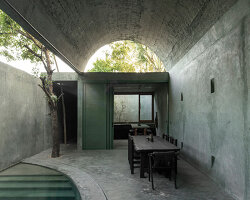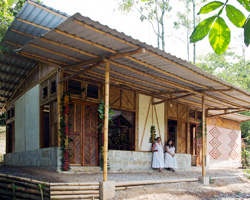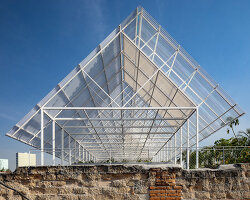in the wake of the two earthquakes that have left parts of mexico devastated, architecture studio comunal: taller de arquitectura visited the state of oaxaca to understand the scale of the disaster. oaxaca was severely affected by the chiapas earthquake, which took place on september 7, 2017 — twelve days before the central mexico earthquake. the architects toured the rural communities to understand their current state and to generate proposals appropriate to the cultural, social, and environmental context.
the essay below is comunal’s response to the natural disaster, and considers the ways in which communities can rebuild their homes and neighborhoods.

all images by onnis luque
on september 7 an 8.2 magnitude earthquake with epicenter on the coast of chiapas hit the isthmus of tehuantepec in oaxaca, leaving 1,479,000 victims. despite it having been the strongest earthquake in the last hundred years in the country, 14 days after the event — according to the villagers — food is not reaching families, support by municipal entities is not flowing, there is corruption regarding the amount of money granted, and there is no proper census of the damages, much less a reconstruction project that tackles the problem in a systemic way.
leaving aside the poor coordination and poor performance that have had municipal and government entities, there is a much bigger problem in the long term: reconstruction.

the first statements by the federal government through president enrique peña nieto on the subject are wrong, irresponsible and have a remarkable burden of ignorance: ‘according to the reports of military engineers and the civil protection area of the state, in addition to the force of the earthquake, the fall of houses was mainly because they are made of adobe and have little foundation.’
this, in addition to being erroneous — since the collapsed housing was built with brick — reaffirms the agenda of public housing policies in mexico for some years, which has become much more evident since 2016 with the operating rules of subsidy for self-construction of the national housing commission: to curb the social production of housing with constructive systems and traditional knowledge to give way to constructors and business.
regarding the construction systems, during our tour in the area we could observe that the houses built with brick had collapsed because they did not have appropriate foundation, chain of foundation, chain of enclosure and castles, which caused them to collapse before the strong movement.

in the interviews we had with some families who became homeless, francisco fuentes martínez, a village in the municipality of unión hidalgo, reported on the modifications suffered by the traditional housing of bajareque and the inclusion of the partition in the region: ‘it is that when we started it was pure tejavana and pure mud, then we saw that the people began to make the bricks and cook them in the oven, then we bought them and began to knock down the mud walls. then we build the walls with septum glued with mixture, but it is not cement, it is calhidra. no house carried chains or foundations, we hit it just like that.’
in another very different scenario, the few vernacular dwellings — built of canelillo wood, bajareque, otate and tiles — that still remain in the region, suffered minor damages such as detachment of the last finishing layer in the ceilings and light cracks. however, the wooden structure continues to function properly. the isolated cases of structural damage was due to the combination of construction systems: brick + bajareque. this makes it clear that there must be an understanding of how systems work structurally in order to not generate incompatibilities that produce failures in the face of earthquakes. the repair of traditional houses is very simple, inexpensive and the villagers have the necessary knowledge to carry it out (some have already started), which is one of the many added values of self-construction with traditional building materials and systems.

regarding concrete, constructions made with this system also suffered serious damage: 262 collapsed schools and 2,000 more with severe structural damage, collapsed self-service stores (milano), public buildings, such as the municipal palace of union hidalgo, and private houses in ixtaltepec. this means that security in the reconstruction should not be associated with such a system, nor should it be promoted as the most appropriate solution for the region, since the inhabitants say that the houses built in this way are extremely hot and uncomfortable.
the second mistake of [president] peña nieto, and perhaps the most serious, was to call on construction companies, ‘those who have carried out important construction projects in the country,’ to collaborate and participate in the reconstruction of the area. it called on companies that profit from housing and the quality of life in rural areas to propose a business model, which is far from being an inclusive and participatory reconstructive process carried out in conjunction with affected communities.

the mercantile dynamics that accompany these companies derive in projects that tend to fall into neglect since they do not start from research and the ethical responsibility of knowing the social, cultural and environmental context before making an architectural reconstruction proposal. in addition, the fiber cement models that already exist in communities such as ‘la blanca’ (municipality of santo domingo ingenio, oaxaca) have, at most, scarce 30 m2 — which is comparable with the measurements of the kitchen in the traditional plot — and are extremely unsuitable for the climatic conditions of the region.
aligned along the same path, the one with no cultural understanding and committed ethics, are the proposals made by the national fund for natural disasters (FONDEN), which aim to function as an emerging and temporary refuge. however, we have visited mayan communities where 15 years after the emergency (hurricane isidoro), the 3 x 3 meter rooms have become the permanent alternative of families causing serious problems of overcrowding. in addition to the above, the proposals are not accompanied by a plan for progressive growth, which makes it difficult for families to expand them over the years.

given this scenario, how should reconstruction be carried out? there are projects carried out in an appropriate manner, such as the one developed by community cooperation with the inhabitants of the montaña de guerrero, which considers primordial aspects that must be taken into account before making an architectural proposal, avoiding falling into creative design exercises decontextualized and irresponsible.

diagnosis: it is necessary to make a diagnosis of damages in the communities where the reconstruction project will be carried out in a specific way, it should not be based on regional generalities.
research: understanding the typology of traditional housing, the construction systems used, the uses and customs, the formation of the lot and the way of inhabiting the territory, as well as the flaws presented by these systems are basic points that will support the proposal.

analysis: once the research has been carried out, all the information collected must be analyzed, and feedback from the inhabitants should be made to ensure that the interpretation is not made from a biased individual imaginary.
participative design: the architectural proposal must arise from the settlers with the architectural guide of the professionals and technicians. never impose forms of living, construction systems or architectural programs that go against local traditions. in this sense, there must be a sensible advice that has as premise the exchange and valuation of knowledge to form an architectural project that contemplates the economy, natural assets of the environment, climate, structural security, services and available infrastructure, as well as the structure and conformation of the families.

appropriate and appropriate proposals: in addition to being appropriate to the social, cultural and environmental conditions of the region, the proposed projects should be appropriate. that is, the proposal must be adequate enough so that the villagers can replicate and modify it according to their needs, even when the guidance team is no longer in the region. the ideal scenario is to create autonomy and independence for the families to rebuild their habitat.

progressivity: all architectural projects must contemplate progressive growth taking into account the particular economy of the community, as well as the constant changes that exist in the family structure over time.
training: in order for families to participate in the self-construction of their homes, training should be given to those who do not know the proper way to use the construction system and thus avoid risks. in addition, it will help foster ownership of the project.
manual: it is very necessary that, even if there has been a training process, the villagers have a manual explaining the construction system of housing, progressivity and maintenance to be provided.

the need for comprehensive habitat reconstruction projects in the oaxacan isthmus and the chiapas coastline is evident. however, as mentioned in the coordinated statement by community cooperation, copevi and the mesoamerikaab network published on september 15, it must be carried out taking into account their capacity for self-construction and the traditional constructive knowledge that they have developed as a people, safeguarding at all times the natural and cultural environment of the zapotec peoples: ‘reconstruction from people and for people!’

designboom has received this project from our ‘DIY submissions’ feature, where we welcome our readers to submit their own work for publication. see more project submissions from our readers here.
edited by: philip stevens | designboom
Save
Save
Save
Save
Save
Save
Save
Save
Save
Save
Save
Save
Save
Save
Save
Save
Save


















